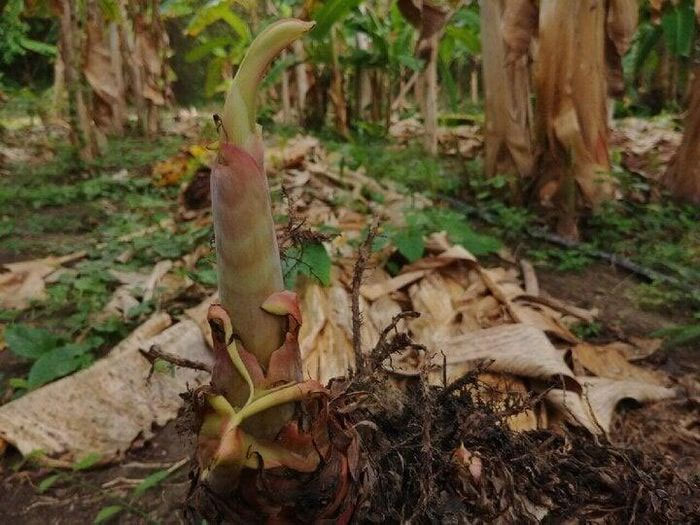Why are banana trees cut down immediately after harvesting?
People unfamiliar with gardening may not know that after harvesting the fruit, the entire banana plant is cut down. Why is this?
Unlike other fruit trees, despite its large appearance, bananas are actually herbaceous plants of the Musa family.
Banana trees have a very special growth process . Although they are herbaceous, they grow vigorously and can reach heights of 3-4 meters. Banana trees are cut down after the fruit has been harvested.
Why banana trees are cut down immediately after harvesting
The reason is simple: Each banana tree bears fruit only once in its lifetime. After the fruit is harvested, the mother tree is usually cut down to make room for new shoots to grow.
When the banana plant bears fruit, new shoots or seedlings begin to grow from the base of the mother plant. These seedlings will develop into new plants and compete with the mother plant for nutrients from the soil. That is why banana plants are cut down immediately after the fruit is harvested. People need to create conditions for the seedlings to grow better.

Each banana tree bears fruit only once in its lifetime. (Photo: Etsy).
After cutting down the mother banana tree, new banana trees can quickly grow . If old banana trees are cut down regularly, the quantity and quality of bananas from the later trees will improve.
163.com explains in more detail why banana trees are cut down immediately after the fruit is harvested:
Due to the nature of banana trees : Bananas are larger than normal fruit trees, their roots are very developed, and can absorb water and nutrients at a depth of more than 1 meter underground. In addition, bananas have a very strong self-recovery ability and can store a lot of water in the tree.
After fruiting, the plant begins to age and wither, but if cut down, new seedlings can quickly grow from the base. Farmers can use old banana plants as fertilizer after cutting them down without worrying about them not growing back.
Felling promotes regeneration : After banana trees mature and age, the nutrients in the tree are gradually depleted, leaving only dry 'empty shells'. Before new seedlings emerge and the old trees have not yet died, the old banana trees have become consumers of nutrients.
The limited use of fertilizer is not conducive to the growth of new seedlings. At the same time, the surface and interior of old banana trees are also important habitats for pests. If they are not cut down, new banana trees may be infected and eaten by pests, which is not conducive to the reproduction and renewal of banana trees.
Give new banana plants room to grow : As banana plants age, the base of the plant will begin to rot and become crooked. When exposed to extreme weather conditions such as storms or heavy rains, the plant may fall over, posing a danger to new banana plants as well as nearby public structures and pedestrians.
Cutting off dead banana plants is a safe measure to protect the new seedlings and also creates more space for the seedlings to grow.
Uses of banana trees after being cut down
Banana trees are grown for their fruit. However, after harvesting the fruit, the trees are usually cut down. To avoid waste, the cut banana trees can be reused in the following ways:
Used for composting
One of the easiest ways to use a chopped banana tree trunk is to compost it. Banana trees are rich in carbon, potassium, and other essential nutrients, making them ideal for composting. Simply chop the tree into small pieces and add them to your compost pile along with other organic materials. Layer the material to ensure proper aeration, and don't forget to water it regularly.
Used as animal feed
Banana plants can also be used as animal feed. The leaves and stems are high in protein and are an excellent source of nutrition for animals such as cattle and goats. It is important to note that the leaves and stems must be thoroughly processed, including cleaning, cutting into small pieces, and fermenting before feeding to animals.
Used for crafts
The leaves of the banana tree can be used to make baskets and other woven items. They can also be used to make paper or as a natural dye. Additionally, the trunk is used to make furniture and other decorative items.
- Marvel at the horned banana tree in Gia Lai
- Strange banana trees show more than 100 flowers
- Banana stalks and incredible benefits
- Planting bananas without ... soil
- The strange banana species in the middle of Xuan Son forest is still alone, finishing and killing itself
- Banana trees become a renewable source of bioplastics
- What kind of banana is the most delicious and added in Vietnam?
- Exotic 'breeding' like figs, bananas produce green flowers in Da Lat
- Do not throw banana peels after eating because they are completely edible like guts
- Preserving and processing bananas
- Techniques for growing avocado trees
- Stunned with extremely rare giant banana varieties
 'Fine laughs' - Scary and painful torture in ancient times
'Fine laughs' - Scary and painful torture in ancient times The sequence of numbers 142857 of the Egyptian pyramids is known as the strangest number in the world - Why?
The sequence of numbers 142857 of the Egyptian pyramids is known as the strangest number in the world - Why? History of the iron
History of the iron What is alum?
What is alum?